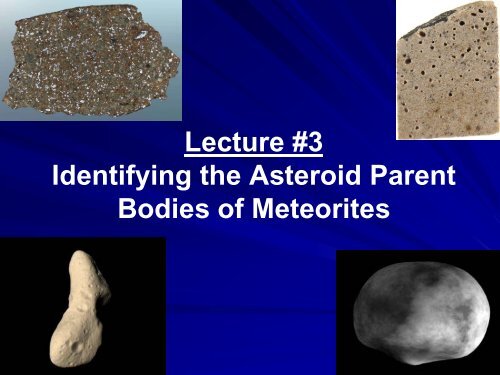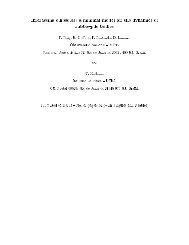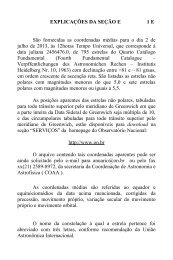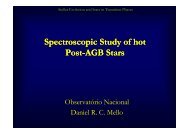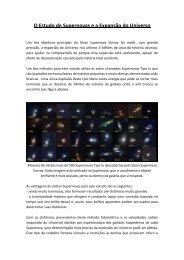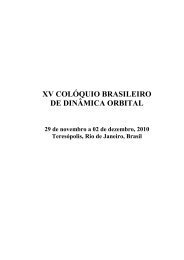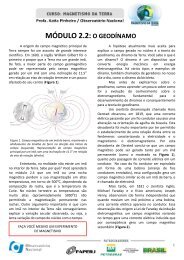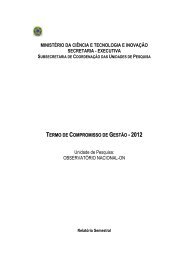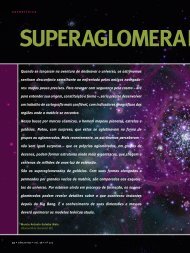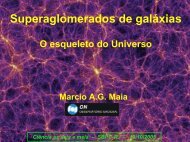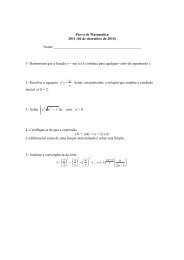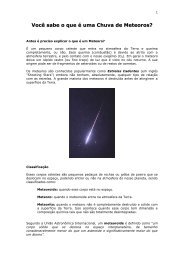IDing Meteorite Parent Bodies
IDing Meteorite Parent Bodies
IDing Meteorite Parent Bodies
- No tags were found...
Create successful ePaper yourself
Turn your PDF publications into a flip-book with our unique Google optimized e-Paper software.
Review of the Asteroid-<strong>Meteorite</strong>ConnectionIt is assumed that most meteorites come fromparent bodies in the asteroid belts.– Lunar and Martian (SNC) meteorites are exceptionsPlausible parent bodies (correct mineralogy)have been identified for virtually all meteoritetypes.The meteorite falls are a biased sample of themeteorite parent bodies.
<strong>Parent</strong> body<strong>Parent</strong> <strong>Bodies</strong> Designations– Actual source body of meteorite– Generally requires a sample return missionProbable <strong>Parent</strong> Body– Correct mineralogy– Delivery mechanism providing appropriate fluxPlausible <strong>Parent</strong> Body– Correct mineralogy– Reasonable delivery mechanismPossible <strong>Parent</strong> Body– Correct mineralogy or Reasonable delivery mechanism
Delivery StagesEjected from asteroid surfaceDelivered to transfer orbit– Generally via a resonanceEncounter the Earth before:– Collisional destruction– Impacting the Sun or other body– Ejection from Solar SystemSurvive atmospheric entryGet recovered
Histogram of Asteroid BeltKirkwood GapsNumber of Asteroids3:1 5:28:37:32.0 2.5 3.0 3.5Semi-major axis (AU)
Secular Resonances (nu / ν )0.5nu(5)2:10.4nu(16)3:1 5:2Sin Incli nation0.30.2nu(6)0.10.02.0 2.5 3.0 3.5Semi-Major Axis (AU)Secular resonances are shown by curved lines.The most important resonances for deliveringmeteoroids into near-Earth space are ν 6 , 3:1 and 5:2.
Getting off of the parent bodyPrimarily due to impact events– Surface fragments accelerated to escape velocityfor parent body– Fragments must generally be in 1 – 10 meter sizerange to produce a meteorite– Amount ejected is a function of material strengthDuring very close planetary flyby, loosematerial may be tidally separated fromparent body– May be important for near-Earth objects
Getting to “Escape Hatches”Spread of ejectafrom four asteroidsDirect injection intoresonances willoccur for favorablysituated bodies.Farinella et al.(1993)i (°)1 4ν 66 463:1a (AU)
Yarkovsky Effect - II. O. Yarkovsky (~1900) – lostPublicized by E. J. Öpik (1951)Rediscovered by V. V. Radzievskii (1952)Rediscovered by C. Peterson (1976)Sunlight is absorbed on front (sunward) faceof bodyIf body is rotating, the warmest region of thesurface is the “afternoon” portionMore radiation is emitted from the warmer“afternoon-evening” hemisphere than fromthe cooler “morning-forenoon” hemisphere
Yarkovsky Effect - IIEffect arises from the asymmetricemission of infrared radiation by a rotatingilluminated bodySunlightVFIR Radiation
Yarkovsky Effect -IIIEmitted photons have momentum, so anequal and opposite momentum is imparted tothe emitting body.Fastest orbital change is for meter-scale (0.1- 10 m) bodies.May increase or decrease the semi-majoraxis depending on direction of rotation.Produces slow secular changes in “a” forbodies from a few meters to 20 km.
Net Effect Depends on Rotation DirectionAdds to orbital velocity, increasing “a”w = warmest regionSubtracts from orbital velocity, decreasing “a”The change in “a” can migrate the object into a resonance
Two Yarkovsky EffectsDiurnal (daily) EffectSeasonal EffectBoth effect orbital elementsDiurnal can increase or decrease “a”Seasonal only decreases “a”
For given albedo and conductivity, Yarkovsky driftrate is a function of rotation rate and body sizeInitial “a” = 2 AU∆a = 0.01 AU / Myr ~ 1.5 km/year ⇒ 0.1 AU in 10 Myr
0.1 AU doesn’t sound like much
Actual meteoroids will not always haveoptimal orientations of their rotation axisModel of Yarkovsky drift for a Hebe fragment, includingrandom rotation axis reorientations by collisionsBottke, Rubincam & Burns (2000)
Extraction from a ResonanceOnce the orbit of a meteoroid has becomeplanet-crossing (Mars, Earth, Venus), a closeencounter can extract it from the resonance.The lifetimes of such extracted meteoroidsare significantly extended.A portion (≈1%) of these planet-crossingmeteoroids will impact the Earth.
Investigators initially assumed that the highabundance of ordinary chondrites meant that most(or many) asteroids had ordinary chondritecompositions.<strong>Meteorite</strong> Fall Frequencies [Wasson, 1974]LLE Chon.L Chon.H Chon.LL Chon.LCV Chon.CM Chon.AubritesCO Chon.CI Chon.UreilitesHHEDsPallasitesMesosideritesIronsAnom. Si-richAnom. Fe-rich
Asteroid Taxonomic ClassesTo understand where this assumption led,we need to understand asteroid taxonomy.In 1975, an asteroid classification systembased on color, albedo, and spectral shapewas developed by Chapman, Morrison andZellner– C-class: low albedos, flat, featureless spectra– S-class: higher albedos, reddish colors, 1 µmabsorption features
Asteroid Taxonomic TypesTholen (1984) identifiedabout a dozen differentasteroid spectral typesusing ECAS (Eight ColorAsteroid Survey) data andalbedos.Subsequent classificationefforts have generallyreproduced this taxonomy.The two most commontypes were the C-group(C,G,B,F ~ 75%) and the S-type (~17%).
Relative distribution of general asteroidtypes versus heliocentric distanceAfter Gradie and Tedesco (1982)
(Ab)Use of TaxonomyOriginal taxonomic group designations werebased on inferences about compositions:C = carbonaceousS = SilicaceousM = MetallicHowever, asteroid taxonomy is NOT, NOT,NOT a compositional classification.Asteroids of different taxonomic classes(e.g., a “C” object and an “S” object) arelikely to be composed of different materials.However, there is no assurance that twoasteroids of the same taxonomic type arecomposed of similar materials!
Identifying Asteroidal <strong>Parent</strong> <strong>Bodies</strong>of <strong>Meteorite</strong>sThe high abundance of ordinary chondrites(OC) among meteorite falls led earlyinvestigators to conclude that they mustcome from an abundant asteroid type.The S-asteroids, which are the 2 nd mostcommon type in the inner belt, have surfacematerials composed of olivine, pyroxene +/-metal.This gross similarity to OC mineralogies ledmany to conclude that most S-asteroids wereordinary chondrites.
Common CosmicMineralsIdentify the types on mineralson asteroid surfaces.Determine the compositionand abundance of thosemineralsWavelength (µm)
The S-asteroid / Ordinary Chondrite ParadoxThe problem with interpreting S-asteroids as ordinarychondrites is that they have significantly different spectraS-asteroid spectra are redderand have weaker features thanordinary chondrites15 Eunomia (S)EitherSpectral differences indicatecompositional differences,and therefore, S ≠ OCOrThe surface of S-asteroids is modified (spaceweathered) in a fashion that changes the spectrum.H4, H6 & LL6ordinary chondrites
Lunar Space Weathering ProcessesVaporized silicates condense on grainsurfaces, producing glassy layers withabundant submicron iron grains.
Tiny Iron Metal Grains in Lunar SoilTiny grains of iron metal condensed from vaporproduced during impacts onto iron-bearing silicategrains.Also reduction of iron-bearing silicates by implantedsolar wind gasses during micro-impacts into soil:FeO + H ⇒ Fe(metal) + OH (H 2 O)
Spectral Alteration by Space WeatheringOn the Lunar surface, space weathering weakens theabsorption features, lowers the albedo, and reddensthe spectrum.
The Problem(s) with Asteroid “SpaceWeathering”Spectrally significant space weathering isNOT seen in meteoritic regolith breccias.Some process(es) is/are altering thespectra of asteroid surfaces.However, the process(es) has/havedifferent effects on different bodies.Eros ≠ Ida ≠ MoonWhatever processes are operating tomodify asteroid surfaces, they appear tohave little effect on compositional analysis.
Space Weathering BehaviorLuna, 433 Eros & 243 IdaThree bodies.Three different styles.No general model forasteroid spaceweathering
Comparison of Space Weathering EffectsObject Albedo FeaturesMoon Decreased DecreasedCorrelated with reddeningIda Uniform DecreasedEros Decreased UniformVesta Increased? Decreased?
Relative Variations of Spectral ParametersBand DepthIdaErosAlbedoCannot be due to a single type of “spaceweathering” process!
ImplicationsAsteroid space weathering is a complexprocess– It will take considerable work to understand thenature and cause of the variations between differentasteroids.How does this current ambiguity affectcompositional analysis of asteroid spectraldata?– Curve Matching– Curve Fitting– Parametric Analysis
Limitations of Spectral MatchingIncomplete catalogWhat is a match?Space weatheringBinzel et al. (2001)
Space Weathering & Curve MatchingSpace weathering affects:– Spectral slopes– Band depthsCurve matching is thus very sensitive tospace weathering– The space weathering process must be wellunderstood to compensate for its effects.– Our present incomplete understanding of spaceweathering introduces a significant ambiguity intoany curve matching results.
Curve MatchingInitially useful in classifying spectraSeverely limited as an advanced analysistechnique– Limited comparison catalog– Effects of space weathering– What constitutes a “match”?Overall, curve matching has probablyproduced more misinformation thaninformation.– Often simply carried too far beyond its“operational limits”
Effect of Space Weathering on DiagnosticParameters - Actual Lunar Samples18016014010084120301507115041Is/FeO12010080Parameters from the spectraof Taylor et al. (2001)6040200Approximate range of ASW0.90 0.92 0.94 0.96 0.98 1.00 1.02 1.04Wavelength (um)No systematic change in Band I positionis evident with increased weathering.
Effect of Space Weathering on Band IIPosition
Relative Band Variations1.08Band I Center (um)1.061.041.021.000.980.960.940.920.90Range of variation inLunar samples dueto space weatheringRange of variation inpyroxene band centersdue to composition0.881.75 1.80 1.85 1.90 1.95 2.00 2.05 2.10 2.15 2.20 2.25 2.30 2.35 2.40Band II Center (um)
Effect of Space Weathering on BandArea RatioMoroz et al (1996)Ueda et al. (2002)Brunetto et al. (2006)
Asteroid “Space Weathering”Where did it go wrong?“Space Weathering” was not observed inmeteorites.It was invoked to reconcile S-asteroidobservations with the expectation that S-asteroids were ordinary chondrites.Recent progress in meteoroid transferprocesses and asteroid compositional studieshave largely negated the expectation thatcommon meteorite types must come fromcommon asteroid types.
A major part of the ordinary chondrite“paradox” was due to the way meteoriteswere grouped and counted.M e t e o r i te F a lLLUnmeltedLMeltedH<strong>Meteorite</strong> <strong>Parent</strong> Body HistoriesKeil, Haack and Scott (1994)Counting individual “rocks”Counting the number ofdifferent types of “rocks”
Actual asteroid compositional determinationsare based on mineralogically-diagnosticfeatures in the spectra of these bodiesNo rmal i zed Sp ect ral Ref l ect an ce1.101.000.900.800.700.600.50Pyroxene4 Vesta0.5 1.0 1.5 2.0 2.5Wavelength (Plagioclase orFe-PyroxeneThese absorption features are due to Fe 2+µm)
Outward-bound Asteroid MissionDAWN– Launched September 2007– Uses ion propulsion system– Will rendezvous with 4 Vesta & 1 Ceres
Asteroid CompositionsTo determine asteroid compositions,diagnostic parameters must be measured.– Absorption features characteristic of specificmineralsReflectance spectra from ~0.4 µm to 2.5 µm– Minimum spectral coverage needed to obtainuseful mineralogical characterizationsOther Observational techniques provideadditional compositional information– Radar provides constraints on metal content– Thermal infrared (5-20 µm wavelengths) canpotentially characterize iron-free minerals
Bottom Line on Space Weathering andCharacterizations of Asteroid SurfaceMaterialsSpace weathering calls into question mostcurve matching results– Curve matching would require – at a minimum – aclear understanding of the space weatheringmechanisms on asteroid surfaces.Interpretations based on diagnosticparameters are essentially unaffected byspace weathering– The main uncertainty lies in the interpretivecalibrations (e.g. band position vs. composition,etc.)
Mineralogical Analysis of S-asteroidsusing Diagnostic Spectral ParametersBand I Center (µm)1,101,051,000,95OlOl>CapxOl-Opx Mixing LineCapx-BearingOl+Opx Opx>Ol OpxOCHED0,900,0 0,5 1,0 1,5 2,0 2,5 3,0Band Area RatioSilicate mineralogy of S-asteroids fromBand I center and Band Area Ratio.
S-asteroid SubtypesBand I Center (µm)1,101,051,000,95OlOl>CapxOl-Opx Mixing LineCa-Px-BearingOl+Opx Opx>OlOpxOCHED (Ca-Px)0,900,0 0,5 1,0 1,5 2,0 2,5 3,0Band Area RatioSilicate components range from S(I) [olivine] to S(VII) [pyroxene].The S(IV) region is defined by ordinary chondrites.
Implications of Mineralogic Diversityof the S-asteroidsUndifferentiated assemblages are onlyfound in the S(IV) region.The further from S(IV), the greater thedegree of igneous processing(melting).Most (>75%) of the S-asteroids haveexperienced igneous melting.
So where do the OrdinaryChondrites come from?Need to look at the mechanisms which deliverasteroid fragments into Earth-crossing orbits.– Farinella et al. (1993) suggested that asteroid 6Hebe should be a significant source of meteoritesbecause of its proximity to the 3:1 and ν 6resonances.– Morbidelli et al. (1994) calculated that based ondynamical models, 6 Hebe should be one of themost important contributors to the meteorite flux.– We were able to use data from previous rotationalspectral observations to characterize 6 Hebe.
A Success at Last!6 HebeThe silicate mineralogy of 6 Hebe isvery similar to the H-chondrites.
Hebe is located near both the 3:1 and ν 6resonances0.5nu(5)2:10.4nu(16)3:1 5:2Sin Inclination0.30.2nu(6)0.10.02.0 2.5 3.0 3.5Semi-Major Axis (AU)Dynamical models indicate that Hebeshould be the single largest source ofmeteorites from the asteroid belt.
Putting it TogetherThe silicate mineralogy is consistentwith Hebe as the H-chondrite parentbody.Dynamical models indicate that Hebeshould be the source of a commonmeteorite type.However, the spectral curve of Hebe issignificantly redder than an H-chondrite.The link between H-chondrites and IIEiron meteorites provided a means toreconcile the spectra.
The spectral curve of Hebe is significantlyredder than an H-chondrite.Hebe looks metal-rich. Impact melts?
Sometimes you get lucky!Portales Valley (Fell – June 13, 1998)Results reported March, 1999 (LPSC)H-chondrite with masses of metalImpact melting?
6 Hebe as the <strong>Parent</strong> Body of the H-chondrites and IIE Iron <strong>Meteorite</strong>sHebe is dynamically suited to deliverabundant meteorites.The silicate mineralogy of Hebe matches theH-chondrites.The H-chondrite parent body has large metalrichmasses on or near its surface.If Hebe is not the H-chondrite parent body,where are all the meteorites that should becoming from Hebe?Verdict? Hebe is the probable parent body ofthe H chondrites.
Where are the L and LL <strong>Parent</strong> <strong>Bodies</strong>?The L-chondrite parent body suffered acatastrophic collision ~480 Myr ago.– >50% of the L chondrites exhibit evidence of a verysevere shock ~480 Myr ago– Breakup of the L-chondrite parent body?– Very large flux (~100x normal) of L-Chondrite(?)meteorites in mid-Ordovician rocks (~480 Myr ago)The L-chondrite “parent body” may be anasteroid family.The LL chondrite parent body is probably oneof the S(IV) asteroids located not too near aresonance.
44 NysaUnsampled Asteroids– Aubrite-like but with ~Fs 0.5-3 enstatite– 0.9 µm absorption feature
Unsampled Asteroids113 Amalthea– ~87% olivine with ~13% pyroxene (~Fs 34 Wo 14 )Normalized Reflectance1.501.251.000.750.50Band I Center Wavelength ( µm)1.101.050.5 1.0 1.5 2.0 2.5Wavelength (um)1.000.0 0.1 0.2 0.3 0.4 0.5 0.6 0.7Band II / Band I Area Ratio
<strong>Meteorite</strong>s as <strong>Parent</strong> Body SamplesThe diversity of meteorite types indicate thatmeteorites are incomplete samples of theasteroid belt.– Some parent bodies are greatly over-represented– Some parent bodies are greatly under-represented– Some bodies are not represented at all!The missing associated assemblages forparticular meteorite types can be inferredbased on geochemical / igneous processes.


